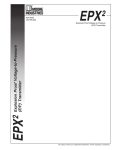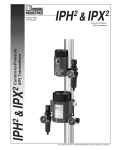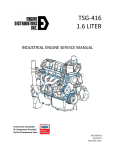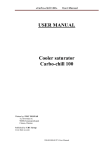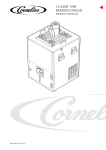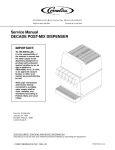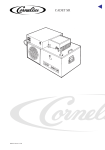Download Suggested manual format
Transcript
Table of Content Page 0. Table of Content 2 1. Introduction 3 2. General Information 3 3. Safety 3 4. Handling and Transportation 4 5. Installation 4-5 6. Installation Procedure 5-6 7. Operation 7-9 8. Fault Finding 10-11 9. Parts Replacements 12-13 10. Technical Data 14 11. Wiring Schematic 15 12. System Schematic 15 13. Spare Parts List 16-18 14. Model Written Scheme of Examination 19-28 INTRODUCTION The UltraFlow dispensing and cooling system is a self-contained, high speed mobile solution for busy places. Developed to meet unique requirements of stadium and event outlets, it delivers beer to a maximum number of consumers in the shortest possible time. By use of intelligent technology, UltraFlow's high throughput system rapidly dispenses measured volumes of beer into a glass or jug, at a consistent temperature and ensures head height, enhanced clarity and freshness. Consumers no longer wait in frustrating queues, brand promise is guaranteed and retailers offer a faster, more reliable service. Ultra Flow is designed to provide rapid dispense in demanding environments of high volume retail. GENERAL DESCRIPTION UltraFlow's unique benefits include: • Fast dispense rate of 4 seconds a pint or 5 seconds per ½ litre • Superior quality and consistency of in-glass dispense • Reduced queuing improves customer satisfaction • Easy-to-use electronic control system permits use of low skilled staff • High sales within a minimum of time • Greater keg yield provided by reducing wastage • Maximum mobility SAFETY Read this booklet before undertaking installation or maintenance. Recognise safety alerts - isolate the power supply before removing panels or carrying out any maintenance. DANGER - Indicates an immediate hazardous situation which, if not avoided; WILL result in serious injury, death, or equipment damage. WARNING - Indicates a potentially hazardous situation which, if not avoided, COULD result in serious injury, death, or equipment damage. CAUTION - Indicates a potentially hazardous situation which, if not avoided, MAY result in minor or moderate injury or equipment damage. Safety Tips – Learn how to operate the Mobile Caddy unit and how to use the controls properly. AUTHORIZED SERVICE PERSON CAUTION- Only technicians who are competent with carbon dioxide (CO2) gas / mixed gas, electricity and plumbing should service this unit. ALL WIRING AND PLUMBING MUST CONFORM TO NATIONAL AND LOCAL CODES OF PRACTICE. CARBON DIOXIDE (CO2) GAS WARNING WARNING – CO2 Displaces Oxygen. If a CO2 gas leak is suspected, immediately ventilate the contaminated area before attempting to repair the leak. − Secure CO2 /mixed gas bottles in an upright position. − Use Food suitable CO2 /mixed gas only − Remember that parts of the device are at operating pressure. Do not loosen or dismantle any components at operating pressure. − Protect internal components against heat sources including sunshine − The CO2 /mixed gas bottle must be connected to a high pressure CO2 /mixed gas regulator. The regulator must be date coded and compliant to local codes of practice. HANDLING AND TRANSPORTATION − − − − − − − − − This unit is heavy, take care when moving Offload the unit from transport as close as possible to the site of intended use Use the handles provided to move the unit Move the unit no faster than walking pace Wherever possible, push the unit rather than pulling as this is ergonomically better and will reduce the risk of foot trapping Moving the unit on flat surfaces o Keep your shoulder, hips and ankles in line, get the power from your legs o Grip the unit at elbow height using the handle provided o Don’t exert yourself to the maximum, get help if needed o Be aware there may be sudden changes of resistance at the intersection of different floor surfaces o Plan in advance for stopping Inclines and uneven surfaces o Seek help from another person when moving up or down an incline and on uneven surfaces Keep the unit in an upright position and do not drag over rough floors or down steps. On receipt, unpack the unit carefully and visually inspect for any damage which it may have sustained in transit. Record the nature of the damage on the Courier’s Delivery Note and at the same time inform your supplier INSTALLATION General Installation must only be carried out by a suitably trained person and comply with national and local codes for CO2 and electrical supplies. It is recommended that in all cases the installation is protected by a RCCB (Residual circuit current breaker) Siting The Player Mobile Bar is suitable for outdoor use The Player Mobile Bar shall not be exposed to rain DANGER Indoor use: The power supply cords of the Player Mobile Bar must be plugged directly into a grounded, 13amp, 230V socket which is protected by a circuit breaker and easily accessible for isolation of the cooler. WARNING The socket shall be installed to current IEE regulations. Outdoor use: The power supply cords of the Player Mobile Bar must be plugged directly into an IP66 ‘weatherproof’, grounded, 13amp, 230V socket which is protected by a circuit breaker and easily accessible for isolation of the cooler. The socket shall be installed to current IEE regulations. WARNING The Player Mobile Bar is designed for ambient temperatures up to 32°C and should not be exposed to water spillage, spray, steam or high humidity (in excess of 90%rh). − The unit must be sited on a firm, level surface − Allow 100mm clearance around the unit to aid air circulation − Air vents should never become obstructed or blocked − Access should be possible to the door for ease of keg change/gas change or service − Do not stand on this unit Installation − The appliance must be earthed − If not already fitted, fit the appropriate electrical plug to the service cord − The device must be in satisfactory condition whenever operated. Any modifications which detrimentally affect the safety of the device are therefore strictly prohibited. Please contact your service company if you wish to obtain more information about safety − With the unit unpacked and in position do not connect to an electrical supply at this stage. Requirements summary The unit requires a bottle supply of CO2 /mixed gas and beer keg. The unit also needs an earthed 13 Amp, 230v socket. There are no other connections. Only non – siphon type cylinders should be used. CO2 /mixed gas cylinders should always be secured vertically with the outlet valves in the uppermost position to prevent injury through ingress of liquid carbon dioxide into the pressure regulators(s). On no account should a connection be attempted to a CO2 /mixed gas cylinders other than a purpose made high pressure assembly, which is date coded in accordance with the relevant code of practice. INSTALLATION PROCEDURE Commissioning Dismantle the unit, to get access to the cooling system and the electric devices. Fill the water bath with water, until the level has reached the pointed height of the water gauge. Energize the cooling device and allow the system to build up an ice bank. At least 4-5 hours! Slide the gas connection through the cut out of the sheet metal part and mount the casing again. Connect the gas tank to the unit. WARNING: Secure the gas tank with the chain to ensure the tank can not fall down. Connect the keg connection as shown with a cleaning tank and clean the complete system as described in “Sanitizing Product Coils”. Afterwards connect product tank to the keg connection. Turn on the CO2 bottle and set the pressure gauge to the required equilibrium pressure +5 psi Turn the switch at the beer monitor to release the gathered foam into the overflow. Activate the pint portion. Check correct operation and ensure the product pipes are fully primed. Check portions are correct using a marked container. Commissioning UltraFlow font (see Operation) OPERATION Programming Normal display will read “Ready” Press and hold “Cancel” button (red lights will alternate on Keg and gas empty) Display will show pint and jugs dispensed. (these readings cannot be altered). Press “Portion 2” button to scroll trough the menu: Press “Portion 2” display will read “pint set up” Press “Portion 2” display will read “Jug set up” Use the “Portion 1” and “Top up” buttons to alter value (this applies to all settings) Press “Portion 2” display will read “Hit (ms)” 100 – Do not alter this value Press “Portion 2” display will read “Hold (%) 020 – Do not alter this value Press “Portion 2” display will read “Pint Timeout” – Do not alter this value Press “Portion 2” display will read “Jug timeout” 40.0 – Do not alter this value Press “Portion 2” display will read “Drain Time” 03.0 – Do not alter this value Press “Portion 2” display will read “Drain delay” 100 - Do not alter this value Press “Portion 2” display will read “Beer saver” 3500 - Do not alter this value Press “Portion 2” display will read “Top up valves 2. Alter between 1 valve or two valves. 1 is for foam, 2 is for clear beer. To exit the program press “Cancel” If settings are lost or forgotten, press and hold “Cancel”, whilst holding “Cancel” press “Portion 2” button and hold for approx 5 seconds. The unit will default to factory settings. Cleaning mode: To set cleaning mode press and hold “cancel”, whilst holding “cancel” press “Portion 1” button, hold both buttons for 5 seconds. This will open the solenoids for approximately 20 minutes to allow fluid to free flow. To stop cleaning press the “Cancel” button. Glass activated dispense: If the glass activated dispense button is used, it must be held on for ½ a second before dispense will start. This is to prevent the possibility of “nuisance” tripping of the system, for example, when cleaning the font. Keg change Slide the keg connection on the tank and push the lever down. It is not possible to push the lever down if it is not slided on the tank correctly. To remove keg, simply pull lever up, and slide it back. CO2 /Mixed Gas Change To change the CO2 tank, remove the connection and the chain, place new tank, add the chain again before connecting the tank to the unit. SERVICE INFORMATION (FAULT / REPAIRS) − There are NO ‘user’ (OPERATOR) serviceable items inside the unit − Maintenance must only be undertaken by a qualified and trained person − Only replace the fuse protecting the circuit to the unit with one of an identical type and rating − Isolate the power supply to the unit during maintenance operations − Only use Cornelius parts for cooler maintenance. Failure to do so will invalidate approvals and warranty PREVENTATIVE USER MAINTENANCE For all of the below, once the maintenance is carried out, follow the Installation instructions for re commissioning the unit − Switch off and unplug the unit during user maintenance operations − − In the event of the unit malfunctions or suffers spillage or physical damage, unplug the unit from its electrical supply Do not switch the unit ‘off’ and ‘on’ within five minutes Sanitizing Product Coils − Under no circumstances should boiling water or steam be used with this unit as it may result in permanent damage. The maximum temperature permissible is 40°c − Sanitize when taste is tainted or periodically as advised by the beverage supplier. − Cleaning process The system will require thoroughly cleaning using a recognized beer line cleaner followed by sufficient clean water to neutralize the system. Employ the standard procedure when cleaning the system i.e. allow the beer line cleaner to remain in the system for approximately 15 to 20 minutes drawing fresh cleaner through the system by operating the pint portion button at approximately 5 minute intervals during the 20 minute soak then thoroughly rinse with clean water using the jug portion button The system can now be connected to a product keg and primed ready for use. PLEASE NOTE: When the CO2 supply becomes exhausted the CO2 cut out switch is set to operate before the line pressure falls below product equilibrium. This will help to ensure that CO2 breakout is kept to an absolute minimum. Once the CO2 supply is reinstated the font will automatically resume normal operation. If the product keg empties the system will allow completion of the last portion before stopping normal dispense operation. Normal operation will automatically resume when new a product keg is connected to the system. Cleaning − Clean parts coming into contact with air and beverage, the mouth of the tap for example, on a daily basis − The external faces of the unit should only be wiped down with a damp cloth. Any cleaning materials should be non-abrasive. Do not use any chemicals to clean. - The condenser fins must be cleaned at regular intervals (approx. Every 3 months). This is best done with a brush and vacuum cleaner. Periodic Testing The 1989 Electricity at Work Regulations require periodic testing of electrical equipment and this should only be carried out by a competent person Daily Inspection − Check the beverage line for leaks. Only a visual inspection is possible. If liquid escapes, call a service technician. − Check the CO2-line for leaks by closing the cylinder globe valve on the CO2-cylinder. The inlet pressure indicated on the pressure regulator should not drop. If it does, call a service technician immediately (upon successfully passing this test do not forget to re-open the cylinder valve afterwards) Putting out of Service Perform the following steps in case of protracted periods without use − Have the device emptied and cleaned. Only trained specialists are to carry out this procedure − Close the CO2-cylinder (valve on top) − Pull the mains plug out of socket − Detach the couplings from beverage containers & CO2 cylinder. − Pull the UltraFlow tower out of the socket and lay it down on the top of the mobile bar and fix it. Parts replacement Technical data Wiring Schematic / System Schematic Spare parts list CR11 Cooler Item Part code 52 220055105 56 143277000 NS 220055074 47 440000236 51 189722000 49 131706000 50 187888000 1 440000704 40 220055172 12 220055102S010 43 147029434 53 58 0446 241 7 141647307 11 142500520 10 220055198 27 220055712S003 25 220098234 23 149550255 24 143350000 41 220094917S019 Description BASE SHEET CR11 ADJUSTING FOOT OVERFLOW TRAY CHROME - SC COMPRESSOR GS 34 TB BOLT BUFFER VIBRATION 32x23 CLAMP CONDENSER STVF 273 WATERBATH CR11 SHEET METAL HOUSING WATERBATH TRITON 250 EXPANSION VALVE TUC 4 MAINS CABLE CONTROL + BOX CPL. ICEBANK ICEBANK PROBE 3 PIN SUPPORT BRACKET ICEBANK PROBE CR11 TIE BAR AGITATOR CR7 RUBBER BUFFER AGITATOR AGITATOR 5/1 CR 4-7 AGITATOR PROPELLER Ø60M5 COOLING COILS ASSEMBLY 4 X 10M 53 Model Written Scheme of Examination for Mobile “Player” Bar This scheme should be completed by the nominated technical person or by a technician on behalf of the nominated technical person. Notes on BBPA Code of Practice Competent Person The design, installation and use of equipment for the pressurised dispense of beer and cider all come to some degree under the Pressure Equipment Regulations 1999, SI 1999 No. 2001(PER) and the Pressure Systems Safety Regulations 2000, SI 2000 No. 128. It is important that retailers, licensees, design engineers, contractors, owners and users of such equipment understand their responsibilities for the safety of pressure systems. The Code of Practice for the Dispense of Beer by Pressure Systems in Licensed Premises (updated 2005) has been produced by the British Beer and Pub Association to assist the above mentioned persons to comply with the Pressure Regulations requirements. The Code clearly suggests the mechanical and organisational requirements for fixed installations to enable compliance with the regulations. Although primarily intended for fixed (cellar) installations it refers to the need for similar controls on mobile/portable installations. To enable these controls to operate and ensure safe use of pressure dispense equipment it defines certain responsibilities for “Authorised” persons, “Competent” persons, owners and users of pressure systems. Of these the most important is the “Competent” person who must have sound practical and theoretical knowledge of the pressure systems and allied equipment used in beer dispense and the appropriate legislation. Such a person will be able to detect errors or deficiencies in any proposed design, and identify those elements of the system which will require periodic examination. He/she will also draw up and/or certify that the written scheme and examination process are adequate. In the case of mobile bars it is suggested that a separate written scheme is introduced for each model of unit taking into account the amount of use and the complexity of equipment involved. Text for further reading:BBPA Code of Practice for the Dispense of Beer by Pressure Systems 2005 (Brewing Publications Ltd) The Pressure Systems Safety Regulations 2000 (SI 2000 No. 128) The Pressure Equipment Regulations 1999 (SI 1999 No. 2001) Instructions for the Safe Operations of Gas Pressure Systems used in the Dispensing of Beers and Lagers published 1998 by Brewing Publications Ltd. Model Scheme for mobile “Player” bar. Mod 28.08.08 Company Name Department Name Written Scheme of Examination for Mobile Dispense system Using Top Pressure Gas Used in the storage and dispense of Draught Beers Wines and Ciders Written scheme number Prepared for: Company Name Company Address Post Code Tel Fax By Dick Ward IMI Cornelius UK Ltd Tything Road Alcester Warks. B49 6EU Tel 01789 763101 Fax Name and Address of Owner Name Address Post Code Tel. Fax. Pressure System Types 1 Carbon Dioxide Pressure System 2 Carbon-Dioxide/Nitrogen Mixed Gas System Location of Records Address(es) of Record Locations Tel : Fax : Scope of this Written Scheme of Examination This Written Scheme of Examination applies to mobile pressure systems that: a) are operated within licensed event areas. b) Are used for distribution of top pressure gases used for the storage and dispense of draught c) beers, wines and ciders; and d) Fall within the requirements of “The Pressure Systems Safety Regulations, 2000”. Only items of plant contained within the mobile system that: Company Name own; or Company Name own and use; are included under this written scheme. This written scheme of examination consists of five sections: Section 1 : Plant to be Examined Section one identifies the items of plant, within the pressure systems, subject to periodic examination. These items are identified by reference to a block diagram for the generic pressure systems used. Section 2 : Items of Plant not to be Examined under this Scheme Section two contains, where appropriate, items of plant within the pressure systems that are not subject to periodic examination under this written scheme. Some of these items of plant may be subject to periodic examination under some other written scheme of examination. Section 3: Preparation and Examination Procedures Section three specifies the nature of any periodic examination that may be required, including any preparatory work necessary to prepare the plant for examination. Section 4: Review Dates Section four states the requirements for reviewing the written scheme of examination. Section 5 : Modifications Section five records any modifications to the written scheme of examination arising from the formal review, or due to any other reason. Legislation The pressure systems used for the storage and dispense of draught beers, wines and ciders are simple. They must comply with legislation. The following Regulations concern the pressure systems, and the components used in their assembly: 1) The Pressure Systems Safety Regulations 2000 (SI2000 No. 128) 2) The Pressure Equipment Regulations 1999 (SI 1999 No.2001) 3) “The Carriage of Dangerous Goods and Use of Transportable Pressure Equipment Regulations 2004” (SI 2004 No. 568) Related Documents a) “Code of Practice for the Dispense of Beer by Pressure Systems in Licensed Premises 1994”, published by Brewing Publications Ltd, June 1994. b) “Code of Practice for the Dispense of Beer by Pressure Systems in Licensed Premises 2005”, published by Brewing Publications Ltd, January 2005. c) “Instructions for the Safe Operation of Gas Pressure Systems used in the Dispensing of Beers and Lagers”, published by Brewing Publications Ltd, April 1998. d) Product Manual and Operating Instructions. Section 1 – Items of Plant to be Examined The pressure systems used for controlling pressure in dispense and storage systems installed in this mobile unit are defined within the Regulations (SI 2000 No.128) as “installed systems”. The pressure systems are also defined as “assemblies” of pressure equipment within the Pressure Equipment Regulations. This gives exemption from regulations 4 and 5(1) and (4) of The Pressure Systems Safety Regulations. A block diagram Figure 1 is used to describe the pressure system used within the specific model of mobile unit. Table 1 describes the various blocks. In figure 1 the parts of the plant that fall within the scope of this written scheme are contained within the blocks labeled “primary/secondary pressure reducing system”. This integral unit contains a primary pressure-reducing element close coupled to a secondary pressure-reducing element, each stage having two protective pressure relief (safety) valves. The items of plant requiring examination are the primary pressure-reducing element in the “primary pressure reducing stage” (normally a pressure-reducing valve, several types being normally used) and the two pressure relief (safety) valves of both stages. Figure 1 : Block Diagram of Pressure System for “Player” Mobile unit used for Storage and Dispense of Draught Beers and Ciders, when using the principle of examination by replacement. Integral Primary/Secondary Pressure Pressure Reducing System with Primary and Source Secondary Protection. Table 1 : Description of Blocks in Figure 1 BLOCK CHARACTERISTICS Pressure Source CO2 Cylinder; Mixed Gas Cylinder Primary Reducing System/ Primary Safety Valves Inlet max. allowable pressure: to suit pressure source; Capacity: max. 66 litres/minute with full cylinder. Maximum allowable outlet pressure to secondary: 150 psig for all gases. Primary Inter-stage ProtectionProtecting Secondary stage components. 2 x Pressure Relief (Safety) Valves mounted on Primary Pressure Reducing Valve: remain seated up to set pressure +10%; re-seat by set pressure -10%; capacity of each valve: minimum 67 litres free gas /minute at max. set pressure +10%. Maximum allowable Inter-stage pressure = set pressure + 10%. Maximum set pressures: 150psig for all gases. Close-coupled Secondary Control Valve with secondary supply protection. Integral Secondary Pressure Reducing Valve with 2 x pressure relief (safety) valves, mounted close in-line; capacity not greater than the Primary Safety Valve; set relief pressure (45psig) below max. safe working pressure of downstream equipment; relieving capacity greater than secondary valve capacity. Section 2 – Items of Plant NOT Requiring Examination Under this Written Scheme Items of Plant Exempted Under this Written Scheme The Regulations except some items of plant from examination. Such items are: 1) kegs (of volume less than 0.252m3 and maximum working pressure less than 12 bar above atmospheric); 2) any small vapour compression plants (less than 25kW total installed power). Items of Plant not Requiring Examination under this Written Scheme Items of plant are not intended to be examined on a regular, defined basis, if it is not anticipated that deterioration will develop and propagate, or which are of a size and nature or installed in a location such as not to constitute a danger in the event of failure. (To qualify for the permitted exception from periodic examination, items of plant should meet at least one of these conditions, in all installations to which this written scheme applies. The competent person must be satisfied that this is so.) Examples of such items of plant not requiring periodic examination under this written scheme include: Gas piping and tubing; piping/tubing/line fittings; secondary pressure reducing valves. Plant and Pressure Systems not included in this written Scheme of Examination This written Scheme of Examination does not cover: Any part of the mobile equipment of which the Brewery Company Name/Supplier is neither the owner or user. Any transportable pressure receptacle (ie compressed gas cylinders), which are subject to other examination regimes by their owners; Section 3 – Preparation and Examination Procedures 3.1 Initial Examination All units are supplied new or refurbished, pre-set (where possible) and tested. There is no requirement for further examination before the unit is put into use. 3.2 Equipment Repairs on Site No major repairs should be undertaken on site. Repairs to the pressure system should only be carried by competent trained service personnel. 3.3 Examination by Replacement The specified parts of the pressure system in this mobile unit will be subject to examination by replacement. Nature of Examination All items identified for examination in section 1 as requiring periodic examination will be “examined by replacement”. (This does not preclude a change to on-site testing. Before any change is introduced into any examination procedure, the competent person must agree the new regime in writing. Any amendments to the written scheme must be introduced before the new/modified procedure is put into practice. Adequate training of affected personnel is essential). Examination by Replacement Preparation: Prior to removal of any component part of the pressure system, the system should be isolated from any source of pressure and the internal pressure relieved. Removal: The part, or assembly of parts, specified to be “examined by replacement” shall be removed with care and diligence so as not to cause any damage or deterioration to either the parts or connecting parts in the system. The removed parts shall be returned to original manufacturer/repairer for testing and recording of results prior to refurbishment. Care should be taken to minimize transit damage. Replacement: Replacement parts shall be new or refurbished to current standard. Replacement must be performed in such a manner that will not cause damage to the parts in question or connecting parts of the system. New or refurbished parts must perform to the same operational parameters as the parts being replaced. No modifications or adjustments shall be made to the parts or system unless specifically required by the specification. Personnel: Only competent trained personnel are allowed to carry out examination by replacement. A record is to be kept of personnel deemed competent and trained for these duties and they should be made aware of their responsibilities. Records: Records of the examination/replacement on the specific mobile unit are to be updated at time of replacement with an indication of next due examination date. Where a part is replaced during normal service/operation, the next examination date remains unchanged. 3.4 Period between examinations: A maximum period between examinations for the pressure system parts is 5 years. The high pressure hose feeding the primary regulator should be examined for damage annually. In addition the electrical parts of the unit will require examination and PAT test at maximum of 12 month periods. 3.5 Response to Imminent Danger: The competent person must, in the event of discovering a material condition which could give rise to imminent danger, inform the owner/owner representatives of the condition and ensure the unit is taken out of use until such condition/s has been rectified. Section 4 –Review Review of the Written Scheme A review by a competent person of this written scheme will take place annually. If the review recommends any modifications to this written scheme, the scheme will be so modified. The following record of review will be kept: Date of review of competent person State if modified (yes or no) Signature Section 5 – Modifications Modifications to this written scheme Modifications to this written scheme will be recorded in the table below. Date of modification competent person Description of modification Signature of




























